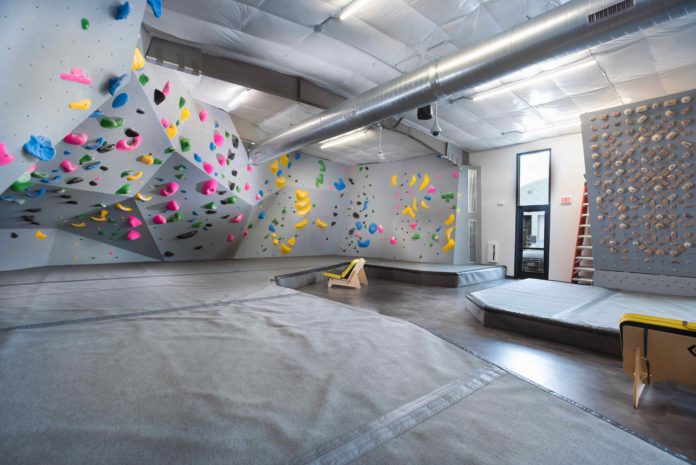
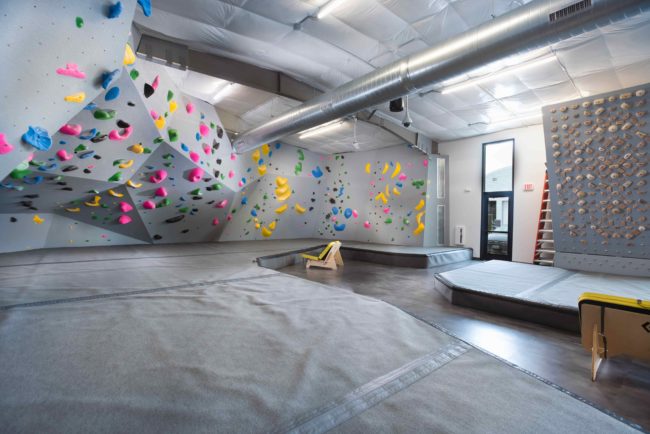
[Branded Content]
The idea that climbing gyms only thrive in markets with outdoor climbing has long been debunked. Since America’s first commercial climbing gym opened in the Pacific Northwest in 1987 and the first bouldering gym claimed its “spot” on The Front Range in 2002, a multitude of gyms have since carved out a niche on The Great Plains. Climbing gyms flocked to Kansas in the last decade, and last year Ohio tied with Colorado as the state with the most new gym openings.
Still, every market poses a set of challenges. Even for experienced owners, opening a second gym carries risks and opportunities. Simply choosing between internal and external expansion is not easy, and then there are the questions of location, climbing type and facility size when launching a new gym project. It can feel like a daunting undertaking, yet expansions comprised more gym openings than ever in 2019.
Climb Iowa was one of the Midwest gyms that took on the challenge of expansion last year, and they couldn’t have done it with confidence without support from Futurist Climbing Consultants.
Recession to Expansion
In 2007, Aaron Stevens was working at IBEX Climbing Gym in Kansas City when Diane Bridgewater walked through the door with a new offer: managing Climb Iowa, a brand-new climbing gym and the first of its kind in Des Moines.
The early years were no walk in the park, with the gym weathering the Great Recession at the outset. By the end of its first ten years, though, Climb Iowa had offered climbing to over 110,000 customers. The gym grew into a staple on the competition circuit too, previously hosting a USA Climbing championship almost every year.
“We always focus on the customers that walk into our gym,” says Stevens, who became co-owner of Climb Iowa in 2011. “The goal we always had was, ‘How do we provide them with the best experience possible and how do we make it easy for them to bring their friends?’ This tactic has been incredibly successful, even to this day.”
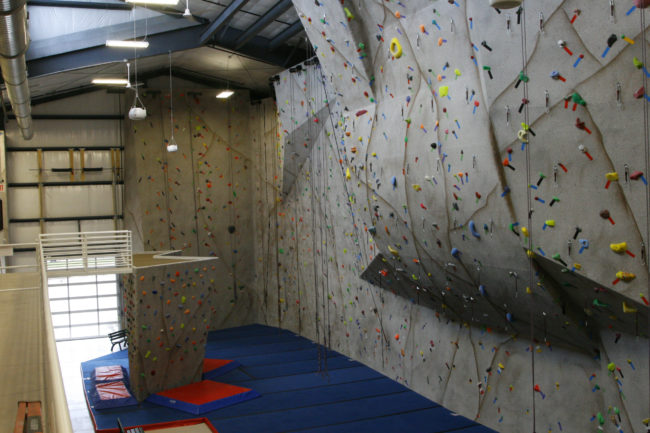
With the first gym now welcoming more than 200 visitors per day, Stevens set his sights on expansion. External expansion was not an option, since there were no other gyms in the area for Climb Iowa to acquire. Renovating the current facility seemed like not enough bang for the buck, either. In the end, Stevens settled on new: reaching new climbers in a new location with a new style.
“The East Village location of Des Moines is the new area that single adults are moving to after college. It is a vibrant area that continues to be revitalized; new apartments seem to go up every few months,” says Stevens.
In the summer of 2018, Stevens announced Climb Iowa would be adding a second climbing gym, this one right downtown. It would go in a steel building next to Peace Tree Brewing and would be geared towards a younger crowd. Different from the full-service Grimes facility, the East Village location would focus on bouldering instead.
Futuristic Consulting
Even with years of running climbing gyms under his belt, Stevens wanted confirmation before investing in a new project. He reached out to former professional climber and World Cup competitor Timy Fairfield, now the Owner & Creative Director of Futurist Climbing Consultants in Albuquerque. Fairfield had run a youth performance training camp and adult climbing clinic at Climb Iowa back in 2009. Plus familiarity of Climb Iowa, Fairfield had years of experience in consulting prospective gym operators and designing over 20 gyms.
Stevens purchased the comprehensive Preliminary Project Assessment package of Futurist Climbing Consultants. The unique consulting service ties together all the various determinants of a gym project (market analysis, customer demand, business model, facility capacity, climbing infrastructure budget, etc.) to establish more informed and fiscally accountable parameters for the gym design – key to adding a gym with confidence.
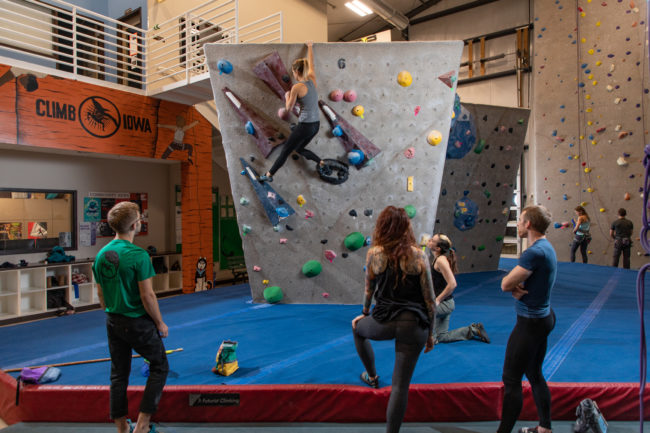
In-Depth Market Research
Fairfield’s task of assessing the Climb Iowa expansion project began with an analysis of the entire Des Moines market catchment area, including the impact of colleges in the area. The goals were to identify the total growth adjusted demand for climbing in the market, determine the existing membership base of the full-service facility and calculate the projected membership base for the envisioned bouldering gym.
Without yet reviewing Stevens numbers, Fairfield estimated the number of members at the Grimes gym. The result was shocking.
“Timy [Fairfield] ran an assessment of our current gym to check on participation rates for Des Moines,” says Stevens. “The day he called me with the numbers, he was within one member of our current membership. I’d say that is pretty accurate!”
Full Transparency
In the US, there are about 40 commercial climbing gyms with 25,000 square feet or more of climbing surface. However, bigger is not always better for every climbing gym. Futurist Climbing Consultants seeks to stand out with forward-thinking industry leadership by taking a different approach. Fairfield focuses specifically on empowering clients in the pursuit of well-targeted and commercially viable climbing gym business ventures.
“Prior to contacting us, many of our clients had been ill-advised by other parties in the industry to build much more climbing surface than they should be purchasing to provide the appropriate capacity for the identified demand,” says Fairfield. “One of the key reasons that we initially formed our company and developed independent consulting services was to provide unbiased and full-disclosure guidance and advice that is aligned with our clients’ business interests.”
After the market analysis, Fairfield developed with Stevens a corresponding budget of the climbing infrastructure which would guide the gym design. They costed out everything from climbing surface to holds and volumes, flooring, fitness machines, routesetting equipment and more. Soon, a re-imagined and realistic design took shape, one reflecting the specific Des Moines market and East Village gym capacity.
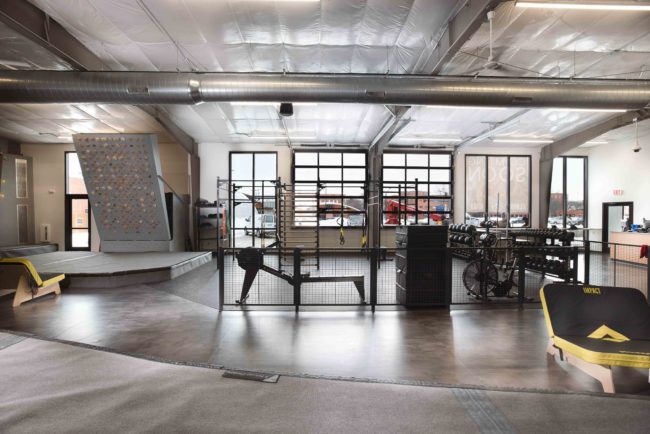
Quality Over Quantity
A full-service gym with mostly roped climbing, Climb Iowa Grimes clocks in at 10,000 square feet of climbing surface, with 37-foot walls. Despite the first location’s success, an honest review of the budget suggested another gym of similar size was not the answer.
“We encourage clients to consider the cost of each extra square foot of climbing surface. Aim for an ideal number of square feet per member expected at your facility,” says Fairfield. “The business model determines how many square feet per member you need.”
With Fairfield’s transparency and market research behind the decision, Stevens settled on quality over quantity for the gym design. East Village would offer just 3,000 square feet of bouldering surface and 1,000 for training. While not the largest in America, Climb Iowa’s quaint new gym with 14-foot walls would fill its function. It would be a cost-effective way to serve the bouldering-focused members of Grimes and reach new climbers downtown.
The Opening
In January 2019, Climb Iowa East Village officially opened to the public, just 6 months after the project was announcement. Besides bouldering, training and fitness offerings, the new gym provides climbing classes, private instruction and a bouldering league. What was the key to expanding the Climb Iowa brand so quickly and with confidence?
“I have worked with Futurist on a variety of aspects of my business. In my experience, they are the most thorough climbing company on the market. They really dive into the numbers, are willing to talk through any scenario and are always transparent,” says Stevens. “They are the best you will find.”
Over the past decade of assessing dozens of market scenarios across the country, Futurist Climbing Consultants has established a refined methodology and project development process that is adaptable and continually evolving to meet the demands of an indoor climbing gym industry in transition.
In addition to expansion facilities, the Preliminary Project Assessment consulting service is also available for multi-phase builds, business model shifts, existing real estate locations, build to suit real estate developments and institutional facilities.
Visit the Futurist Climbing Consultants website for more information and to request a free quote.

.

Climbing Business Journal is an independent news outlet dedicated to covering the indoor climbing industry. Here you will find the latest coverage of climbing industry news, gym developments, industry best practices, risk management, climbing competitions, youth coaching and routesetting. Have an article idea? CBJ loves to hear from readers like you!






